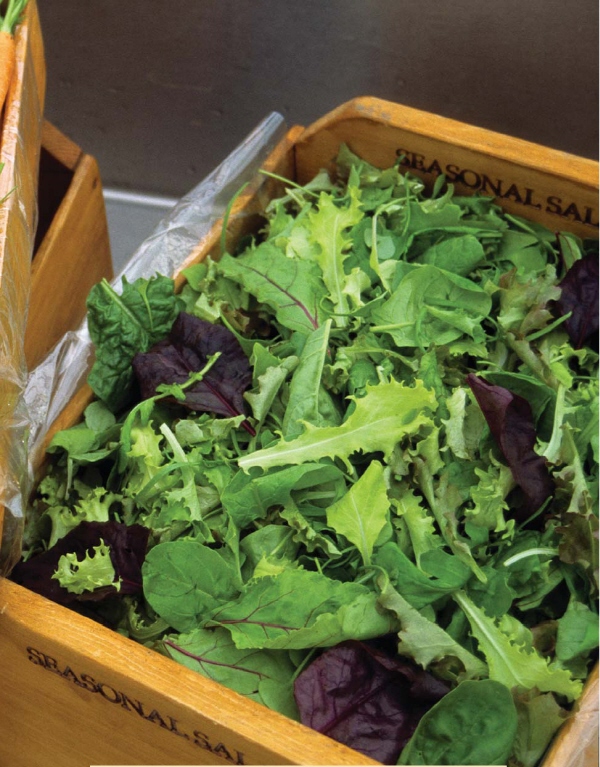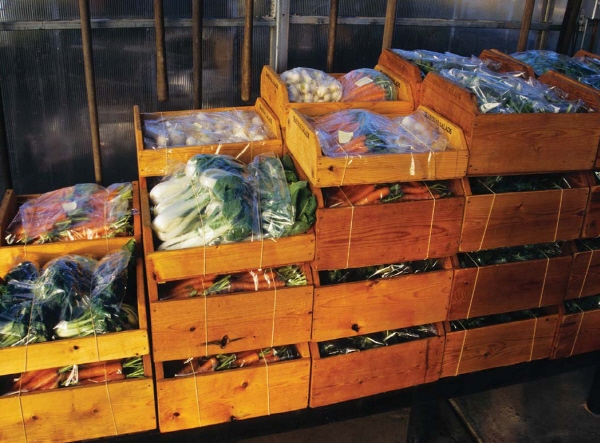

. . . there are many discontents in agriculture which seem to add up to a new vision of “biotic farming.” Perhaps the most important of these is the new evidence that poundage or tonnage is no measure of the food-value of farm crops; the products of fertile soil may be qualitatively as well as quantitatively superior. We can bolster poundage from depleted soils by pouring on imported fertility, but we are not necessarily bolstering food-value.
—ALDO LEOPOLD, A Sand County Almanac (1949)
I have been involved in organic agriculture since 1965. In those days the distinctiveness of organic farming gave small growers a unique marketing advantage. Small growers lost that niche when organic became industrialized. Nowadays more and more organic produce is available from faraway sources. Unfortunately, industrial organic produce is nowhere near as well grown or as flavorful as the organic produce from a small family farm. The “profit at all costs” mentality of industrial organics has undermined the traditional values that motivated the organic pioneers. Consequently the word “organic” isn’t an adequate distinction anymore. Small farmers need a new way to advertise the superiority of their produce. The important words we have stressed ever since the USDA became involved in organic certification are fresh and local!
No matter who grew it or how it was grown, produce shipped from faraway is at least a week old by the time it gets to where we live. Long-distance produce is not “fresh” by any definition. Astute eaters, the types who regularly shop at roadside stands and farmers markets, know the superiority of truly fresh vegetables, and they seek out local growers. In order to attract and keep those appreciative food lovers as loyal customers either at our farm stand or in the stores to which we sell, we have focused on establishing a reputation for quality. In addition we have further branded our produce through imaginative packaging.


Beautiful crops and professional presentation are the keys to selling everything you can grow.
Packaging
We pack for delivery in our own distinctive 12-by-16-by-8-inch wooden boxes, which are homemade from native Maine cedar trees cut on our farm and turned into boards on a neighbor’s saw mill. We decided on the reusable box idea years ago after reading that 25 percent of the volume in the average landfill was food-packaging waste. Since we sell only to local markets, it was easy enough for us not to contribute to that waste stream by making our own permanent boxes. Since the store managers approve of the idea, they save and return our boxes to us.
After construction we sand the boxes smooth and coat them with a food-grade finish. Our trademark, “Seasonal Salads,” has been burned into the end boards of each box with a branding iron. These boxes look very attractive in produce coolers, catch the customer’s eye, establish brand loyalty, and help sell whatever they contain. We determined the size by measuring produce coolers in stores and also measuring the back of our car. At the start, a small business can’t afford a separate delivery vehicle. Therefore, we needed to be able to put up to forty-eight boxes in the back of our Subaru for delivering. Once the business grew to the point where we had to make two or three trips each delivery day, we purchased a used van.

Produce boxed and ready for delivery.
Before being filled, the boxes are lined with a sheet of pure cellophane that folds over the top of the ingredients and is held in place by two rubber bands. We chose cellophane over plastic because it is made from wood fibers. That seemed a more appropriate choice than plastic since wood is one of the products of our farm. We also appreciated the fact that this is pure cellophane, which can be composted for disposal after use. Each time we deliver produce to our customers, we pick up the empty boxes from the previous delivery. Back at the farm, we clean the boxes with hot water and store them for the next harvest.
Setting Prices
Before we walked into stores and restaurants in October 1995 with our first commercial winter-harvest crops to sell, we calculated the wholesale price we needed to receive in order to make a “fair” return. Our price was $2 per pound higher than the price that week for California organic salad mixes, but we were confident in our product’s superior quality. The local food co-op took a few boxes for trial and set ours side by side with the West Coast competition. A day later ours had all sold and the competition was still sitting there. The co-op realized that customers were willing to pay more for our obviously fresher product. Chefs immediately recognized the quality and the marketing cachet of serving a “local” salad, and they were further gratified by the freshness of our mix since the week-old imported product they were buying had a short shelf life after delivery. In one local store, where they had never carried our sort of products before, the quality of our salad and other vegetables created a market. For their convenience we pack the salad in quarter-pound bags as opposed to bulk boxes. That account has now expanded to eight times the initial quantities.
HEALTH ASSURANCE
We have often suggested that the average American spending hundreds of dollars a month on sickness insurance would be wiser to invest in health assurance by spending an additional $10 per day on high quality local fruits and vegetables. That would increase the market enormously for local growers and benefit their customers an equal amount. The two areas of human activity that we consider most important to the well-being of the human species—nourishing bodies with exceptional food and nourishing minds with exceptional schools—are two of the most neglected and underpaid in our culture. We will continue to make the case that quality produce and quality people are worth a “good” price.
When it comes to food prices, “fair” has two different meanings— “affordable” and “equitable.” The most difficult challenge for the small-scale grower producing high-quality vegetable crops is charging an equitable price—sufficient to make a decent living—without being accused of being elitist or unfair. Even though most people can easily discern the quality difference between brands of automobiles or appliances, that same astuteness, with the exception of visible cosmetic quality, does not seem to be applied to vegetables. The myth has been successfully planted in the public mind (possibly for the benefit of homogeneous supermarkets) that biological quality differences do not exist and a carrot is a carrot is a carrot.
That myth is patently untrue. In forty years of growing crops and feeding livestock and people I have seen many striking examples of superior biological quality in properly grown crops. There is as much quality difference between our carrots and run-of-the-mill supermarket carrots as there is between a Volvo and a Corvair. And there is a similar difference between local “organic” and imported “organic.” The small-scale local grower can produce a more finely crafted product through meticulous attention to soil care, superior compost, and variety selection than can the large-scale shipper. Add the obvious benefits of fresh over week old (we deliver within twelve to twenty-four hours after harvest), and there is no question: the dedicated local grower is selling a premium product and deserves a premium price commensurate with that quality.

Young ‘Bianca Riccia’ endive.

Our farm stand with perennial flowerbeds in front.
Higher food quality is a plus in marketing both for us and for the stores that retail our produce. Every day more articles are published in peer-reviewed journals attesting to the nutritional superiority of food raised with organic and other natural techniques. According to studies on levels of antioxidants in vegetables, the winter harvest would seem to offer an additional benefit. Highly colored foods grown under cool conditions have been shown to be much higher in anthocyanins, one of the most valuable antioxidants. One example where this can be easily noticed is in the much deeper red color of red lettuces and ‘Bull’s Blood’ beet leaves from the winter greenhouse. Green leaves can also be high in anthocyanins since they utilize them to resist cold. It will be interesting to note what future research determines about the enhanced nutritional quality of cold-weather crops.
Making It Pay
When we began commercial winter production, we set a target return per square foot for our 12,000 square feet of greenhouse space in order to create an economic guideline for ourselves. We figured on getting three crops per year from each square foot of unheated production and set a target of $5 per square foot for the year. This is about one-third of the expected return per square foot in large heated commercial greenhouses growing flowers. That seemed reasonable since we did not have heating expenses and we were growing vegetables rather than the more pricey flowers. In the cool houses we figured on six crops per year and aimed for a $10-per-square-foot yearly return. Thus it was obvious that each crop had to return just over $1.50 per square foot. Those computations have been very useful in helping us to judge which crops are paying their way.

One year, when we had extra outdoor carrots in late fall, these “Thanksgiving Gift Packs”helped us triple sales.
At the start we knew we were entering unknown realms with our winter harvest and had a lot to learn, so we gave ourselves five years to reach the target gross. In the early years we made all the mistakes this book is attempting to spare others from making—poor timing of plantings, poor choice of cultivar, inadequate knowledge of regrowth characteristics, plus many square feet devoted to trial crops that didn’t work out and were never salable. All of those limited our returns. Still, increase in income has been steady and we have achieved a gross return from both field crops and greenhouse crops together of $80,000 per acre per year. Impressive as that may sound, keep in mind that it is not gross income but net income that makes a living for the farmer. Much of our present effort in trying to develop new tools is an attempt to make our operations ever more efficient and improve the net by cutting down on labor costs.